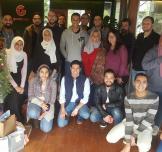Five Innovative R&D Solutions by Egypt's Researchers

Information Technology Development agency (ITAC) has released its latest newsletter and it has five news pieces on developments in research and development and ICT from research institutions all over Egypt in collaboration with international institutions. The five findings have local and international applications that are meant to solve world problems with scientific methods.
1) Si-Ware and Cairo University Develop an Inertial Stabilization Platform
Researchers at Si-Ware Systems and Cairo University have developed indigenous technology for inertial stabilization platform (ISP) systems and their components.
“ISPs are electromechanical platforms attached to moving vehicles and are intended to carry a payload and maintain the payload line-of-sight or track external objects irrespective of the motion and disturbance caused by the vehicle,” says Dr. Amr Wassal, Si-Ware Vice President, Operations & Systems Engineering.
The developed ISP combines Si-Ware’s Micro-Electrical-Mechanical-System (MEMS) inertial sensor integrated circuits expertise with newly developed mechanical design, embedded control, sensor fusion algorithms and inertial measurement unit expertise. It can be used to mount light payloads such as daylight cameras, infrared cameras, laser range finders, small phase array antennas on moving vehicles.
“Si-Ware is aggressively marketing its production-ready ISP and is expecting a small-volume production order from a potential customer currently assessing the product,” Wassal says.
2) A Microfluidic Platform Developed at Zewail City for Liver Cells Detection, Identification and Sorting
A group of researchers from Zewail City of Science and Technology and Helwan University has presented a microfluidic platform that has been successfully utilized to identify and characterize the liver cancer cells based on their electrokinetic reaction when exposed to a non-uniform electric field, i.e., dielectrophoresis force.
“The study of the dielectric properties of liver cancer cells is of interest to scientists worldwide and particularly in Egypt. Egypt is ranked fourth in the world for liver cancer disease. Thus, it is critical for the Egyptian economy to find ways to reduce the cost of liver cancer cells detection and identification,” says Prof. Yehya Ghallab, associate professor at Helwan University.
The microfluidic platform includes three different dielectrophoresis configurations. They are traveling wave, electro-rotation, and levitation. The platform employs planar microelectrode array, which is fabricated using the low-cost Printed Circuit Board (PCB) technology. “Analysis of the electro-kinetic properties showed that Adipose stem cells (ASCs) displayed different traveling wave velocity and rotational speed compared to bone-marrow mesenchymal stromal cells. Interestingly, ASCs seem to develop an adaptive response when exposed to repeated electric field stimulation,” Ghallab Says. Click here for more info.
3) BlinkApp! Reporting Car Accidents in a Blink of an Eye!
Researchers from Egypt-Japan University (EJUST) and BenaIT company have developed a novel mobile application called “BlinkApp” that uses the smartphone to automatically detect car crashes and transmit assistance notifications while it’s happening and yet does not consume much power.
Mr. Wael Nofal, BlinkApp CEO, stated that rapid emergency services calling when an accident occurs can potentially save 1200 lives in Egypt, annually. “
This research provided novel technologies that rely on fast on-phone graphics processors, Artificial Intelligence as well as accurate crash dynamics. An initial prototype is developed and tested using detailed simulation, micro crash labs, and mathematical models; results show high detection accuracy of 98%, and low power as GPS is not used,” says Prof. Ahmed Elmahdy, associate professor at EJUST and the principal investigator of the project.
4) Researchers at the British University in Egypt Optimized Tuning Mechanisms in Radio Frequency (RF) Resonators
Researchers from the British University in Egypt and the University of Bristol, UK have proposed a new geometric method of bandwidth control that automatically allows center-frequency preservation in RF resonators.
“Advanced telecommunication systems, such as 5G and agile radio, are complicated radio systems that require a new approach in design and optimization. RF filtering forms a “bottleneck” in the face of achieving full frequency agility (multi-band/-mode operation), due to its inherently frequency-tuned nature. Designers today need to find new solutions that would enable agility in these filters,” says Prof. Adham Naji, project principal investigator.
“In this work, we focused on optimizing the building blocks that makeup RF filters; namely, RF resonators. By addressing tunability at the resonator-level, we leverage filter-level design with greater understanding,” Naji says. Click here for more info.
5) Detecting Emotional Tone and Sentiment Targets in Arabic Tweets
A group of researchers at Nile University has developed a working prototype that has the largest and most diverse Arabic dataset for emotional tone detection.
“There is a need to not only identify sentiments in Arabic text, but also the target of this sentiment. Also, there is a need to recognize emotions conveyed in some piece of text,” says Prof. Samhaa R. El-Beltagy, associate professor at Nile University.
Emotional tone detection is a task that is very close to sentiment analysis, except that the output is more fine-grained.
“Emotions that this work has targeted include happiness, anger, sympathy, sadness, fear, surprise, and love,” El-Beltagy says. Click here for more info.
Photo Credit: publicdomainpictures






































































EgyptInnovate site is not responsible for the content of the comments